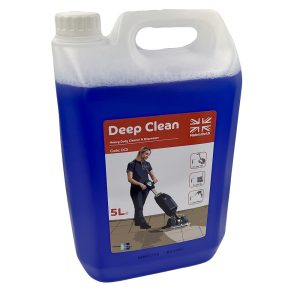Getting to know vacuum cleaners…
Why Choose An Upright or Tub Vac?
First of all, let me describe the basic difference between tubs & upright vacuum cleaners…
A tub vacuum (also called a cylinder or canister vacuum) is a container with a motor clipped to it. There will also be a filter in between the motor & the tub. The tub has a hole in the front which a hose screws into.
When the motor is switched on, its internal fans spin around creating suction. The power is such that this suction pulls the air (& dirt) from the floor, up the tubes & hose, through the dust bag, through the filter & then is expelled out of the motor head of the vacuum. The dirt is collected in the tub, usually in a disposable bag, and the air is cleaned by the cloth filter.
This video explains the above much better than me.
The model shown in the above video is the Henry Xtra, which has an air-driven beating brush. The difference with an upright vacuum is that the beating brush is normally driven by the motor & therefore can beat the carpet much more effectively as shown below where this upright is pulling itself along. This looks like a setup gif but this exact scenario actually happened to me in our old showroom. I switched an industrial upright vacuum on & it shot across the room eating an entrance mat as it shot by….all in front of a customer! 😬

In short, most people express a preference for an upright or a tub. In general, uprights are more effective on carpet & tubs are better on hard floors. I would say that the user can stand more upright with an upright, so might be viewed as more ergonomic as long as stairs aren’t involved!
Tubs are harder on the back but usually much cheaper. If a client only has hard floors I would always suggest a tub vacuum.
Henry & The Tub Vacs
One of the most common types of vacuums you’ll encounter is a tub vacuum and the most famous of all of them is Henry.
Henry was born just a few miles away in Chard, Somerset & we were there at his birth & we became one of his 1st distributors in the world!
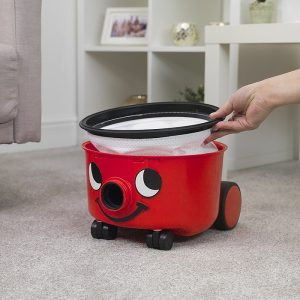
The Henry vacuum cleaner is one of the most popular vacuum cleaners to have been created and is a favourite in the UK
Now while we sell the Henry, this particular model is now aimed at the domestic market and we are a commercial distributor. So, we favour Henry’s big brother, the NRV240…
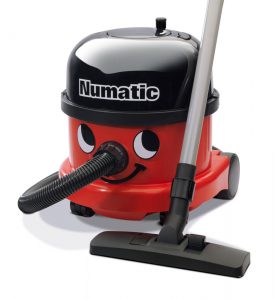
Sporting a better price for commercial buyers, a larger 9L capacity, a more stable base, and a longer cable, this version of the Henry is the workhorse of the commercial cleaning world. The only issue is he’s lost his name at the top 😢. You’ll be hard-pressed to find a machine that provides better value for money.
There are lots of different types of tub vacuums but for now, an overview of the different features is as follows:
Tub size/capacity: This is how much dirt, dust & debris will the drum hold. This is described in litres.
Motor Wattage: In Numatic machines, this ranges from 420w to 620w. Higher wattage doesn’t always mean more power – think of a modern LED compared to an old-fashioned light bulb.
Cable: Different vacuums have different lengths of cables. Also, some cables plug in (like a kettle plug), some are hard-wired & would need an engineer to replace it.
Cable – Loose or Rewind: Some vacuums like the NRV & Henry have a knob on the top that you turn to wind the cable up inside the drum. Other vacuums just have a loose cable that flops about!
Tool kit: The metal tubes can be aluminium or stainless steel, hoses can be different lengths & there are loads of different types of tools.
Finally, a few years ago I worked out that if I balanced every Henry we have ever sold on top of each other they would go all the way to the top of Everest & back down again. I worked this out more than 10 years ago so I wonder how much higher the pile would go now! 😲

Sebo – Upright Vacuums
Now, we’ll be looking at the Sebo range of upright vacuums.
Upright vacuums usually offer unparalleled cleaning ability on carpets where the beating action of the brush roll literally scrapes, brushes & beats fluff, hair & debris that is caught in the carpet pile… or the dog’s fur!
Sebo BS360: The Powerhouse Performer 🚀💪
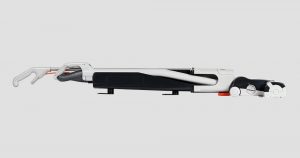
The Sebo BS360 is a robust and reliable commercial vacuum cleaner. It’s designed for heavy-duty cleaning tasks in large spaces such as offices, hotels, and industrial facilities.
- Powerful suction: The BS360 boasts exceptional suction power to pick up dirt and debris effectively.
- Large capacity: Its spacious dust bag means less frequent emptying, increasing productivity.
- Durable build: Built to withstand demanding environments, the BS360 is designed to last.
- Exceptional power from 2 motors – one for turning the brush & one for suction (most vacuums only have 1 motor).
- 14″ cleaning width.
Sebo BS460: The Expert in Efficiency 🏢📈
The Sebo BS460 is the same as the BS360 but its 18″ wide rather than 14″. This suits hotels or large offices with long, wide corridors.
- Intelligent design: The BS460 features an ergonomic handle and intuitive controls for user comfort.
- Automatic height adjustment: It adapts to different floor surfaces, ensuring optimal cleaning results.
- Advanced filtration: The BS460 includes high-quality filters to improve indoor air quality.
Watch this video on the 360/460:
Sebo Dart: The Compact Cleaning Dynamo 🧹🌟
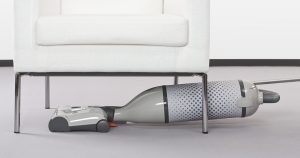
The Sebo Dart is a versatile and compact vacuum cleaner suitable for a wide range of commercial applications. It’s known for its maneuverability making it most popular for hotel bedrooms.
- Compact design: The Dart’s small size makes it easy to maneuver in tight spaces.
- Versatility: It’s suitable for both carpets and hard floors, making it adaptable to various cleaning needs.
- Quiet operation: The Dart operates quietly, ideal for noise-sensitive environments.
Watch this video on the Dart:
–
Key Differences: 🔑
Now, let’s highlight the key differences between these Sebo vacuum cleaners:
- Size and Portability: The Sebo Dart is the most compact and maneuverable, making it ideal for smaller spaces. The BS360 and BS460 are larger and better suited for larger areas.
- Uses: The BS360 and BS460 are specifically designed for commercial environments (especially those with difficult corded carpets), while the Dart is also popular in households.
- Controls: are all user-friendly and ergonomic designed for ease of use.
- Noise Level: The Sebo Dart is quieter in operation compared to the BS360 and BS460, which is important for noise-sensitive locations.
In conclusion, Sebo offers a range of commercial vacuum cleaners designed to meet different cleaning requirements. The choice between the BS360, BS460, and Dart depends on factors such as the size of the space, cleaning needs, and environmental considerations. Understanding their unique features and differences will help you make the right choice for your specific cleaning tasks.
Backpack Vacs
Backpack vacuums can be up to 3 times more productive than regular upright vacuums, saving businesses time and money! 💵
Have a watch of this video about the pros and cons of a backpack vacuum. Start at 2 minutes in, there is a paid promotion at the beginning.
We currently offer 2 brands of backpack vacuums Numatic and Pacvac. Numatic make many types of vacuums and other cleaning machinery. Pacvac are an Australian company that specialises in backpack vacuums. You’ll find the most popular choice of backpack vacuums are cordless, battery-operated machines as they allow the user to move around freely. Mains powered machines are much cheaper than battery so we do still sell these too, the first of which is the…
The RSV is compact comfortable, and as it is powered by 240v it’s very powerful!
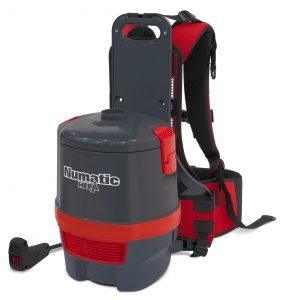
The RSB150NX is the battery version of the RSV. We sell single & twin battery versions.
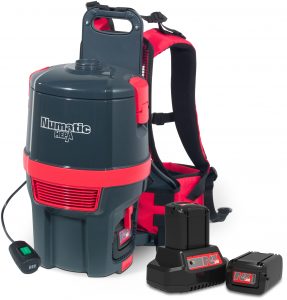
This vacuum is a mains-powered backpack vacuum. People like the Pacvacs as they can see the dirt they are picking up through the clear lid.
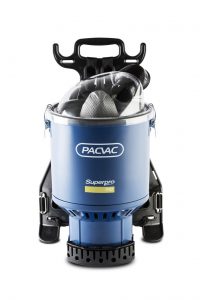
The VB700B is the battery version of the Superpro 700. It comes with 4 batteries so has the longest run time of all of the battery backvacs.
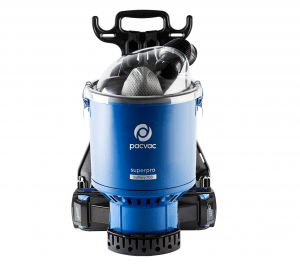
The Velo is Pacvac’s lightweight alternative to the Superproo 700, its only comes in a battery version.
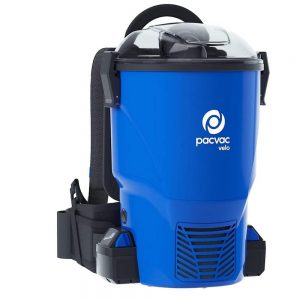
Click here for a blog article we’ve written comparing the Numatic RSB to the Pacvac Velo.
Cordless Vacuums
Cordless vacuums can come in many shapes and sizes. They incorporate the backpacks vacuums you’ve already seen and more. The benefit of a cordless (battery-powered) vacuum is the increased ease of use, maneuverability, and safety as there is no cord as a trip hazard.
Here are a couple of the most popular cordless vacuums not already covered.
This is the cordless version of the commercial Henry we covered in a previous topic.
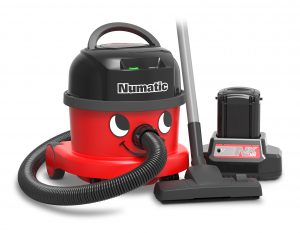
The Numatic Quick is the only upright battery-driven/stick vacuum we sell. This type of vacuum has become more & more popular in recent years, particularly in households.
The difference between the Numatic Quick & Dysons & Sharks is that it has been designed and tested for commercial use & is also warrantied for use in a commercial environment.
This machine brings all the benefits of powerful cordless cleaning with no dust, no mess, and no fuss. It’s the perfect solution for busy people who want a quick and easy way to clean. This battery-powered vacuum has a runtime of 120 minutes (60 minutes per battery), so you can clean your entire house or office in no time. Plus, the high-efficiency filter pod system captures more dust than many leading stick vacuums. The Numatic Quick compacts dust inside a high-efficiency filter pod system for a bigger capacity than many leading stick vacuums and hygienic, dust-free emptying.
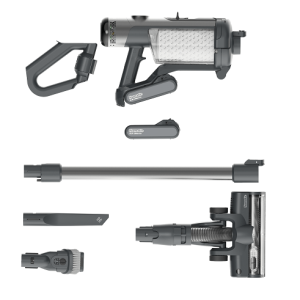
Wet & Dry Vacuums
Now we will get a little more tricky with vacuums designed to pick up liquids. Many offer both wet and dry cleaning. They are designed to handle various messes, from dry dust and debris to liquid spills. These machines are essential in residential and commercial settings, offering the flexibility to tackle various cleaning challenges.
The wet vacuums that we sell are classified as either:
- Wet & Dry – they can pick up liquids and dust & debris, so are supplied with a float valve & a dry filter.
or
- Wet Only – they can only pick up liquids – supplied with a float valve & no filter (although one can be bought later).
In wet mode, there is s a float valve on top of the drum. The float valve shown below is a cage with a ball in it. As the drum fills with water the ball raises up & cuts off the suction to the motorhead. If it didn’t do that the the water going through the motor would blow it up!
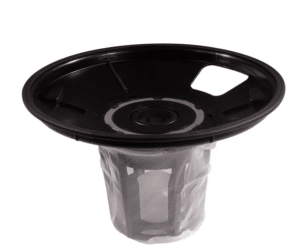
When you are swapping from wet mode to dry mode. You would remove the float valve, pour away the dirty water, dry the drum, fit a dust bag & a cloth filter:
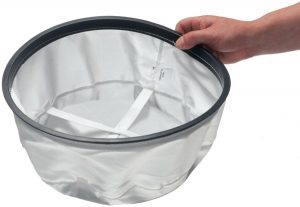
There is one exception to the above rule of having to change the float valve & filters to go between wet mode & dry mode. Numatic has recently developed a range called CV, which allows you to pick up dust, debris & liquids without making any changes. We will be adding them to our site & doing a video soon. 👍
The main differences between the wet vacs are the capacity and suction strength. Some are equipped with dual motors for extra power. It will depend on your customer’s needs as to which vacuum they go for.
We have a wide range of wet vacs you can find here.
Industrial / Hazardous Vacs
Industrial vacuums are powerful cleaning machines designed for heavy-duty cleaning tasks in industrial settings such as construction sites and manufacturing facilities. They are built to handle larger debris, dust, and potentially hazardous materials that typical household vacuums cannot.
Industrial Vacuums
Industrial vacuums are powerful cleaning machines designed for heavy-duty cleaning tasks in industrial settings such as construction sites and manufacturing facilities. They are built to handle larger debris, dust, and potentially hazardous materials that typical household vacuums cannot.
Key Features:
Robust Suction Power: Industrial vacuums are equipped with powerful motors capable of handling large volumes of debris, including metal shavings, concrete dust, and more. 💪🔌
Durable Construction: These vacuums are built to withstand the rigours of industrial environments, often featuring sturdy metal or heavy-duty plastic construction. 🛠️🏗️
Large Capacity: Many industrial vacuums have sizable collection tanks or bags to minimize downtime caused by frequent emptying. 🚛🧼
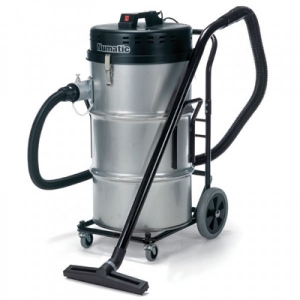
Hazardous Vacuums
Hazardous vacuums are specialized machines designed for safely cleaning up and managing hazardous materials, including toxic dust, chemicals, and biological contaminants. They are used in environments where exposure to such materials could pose health risks. These are 2 main classifications M (medium risk) & H for high risk such asbestos.
Key Features:
Advanced Filtration: Hazardous vacuums employ advanced filtration systems, including HEPA (High-Efficiency Particulate Air) filters, to trap hazardous particles and prevent their release into the air. 🌬️🔒
Sealed Construction: These vacuums are often designed to be airtight, preventing any leakage of hazardous materials during operation or disposal. 🚫💨
Compliance with Safety Standards: Hazardous vacuums adhere to strict safety standards and regulations to protect both users and the environment. 🚧📜
M-Class H-Class & Explosive Dust Ratings: Managing Hazardous Dust 🌡️🧹
It’s important to note that businesses have a legal obligation to provide the appropriate vacuum to their staff. The classification of a vacuum is dependent on what they are picking up.
M-Class Rating (Medium Hazard):
The M-Class rating is associated with dust that poses a medium hazard to health.
M-Class vacuums are equipped with advanced filtration systems, typically including HEPA filters, to capture fine dust particles.
They are suitable for environments where exposure to dust like wood dust, plastics, and non-hazardous construction dust could pose health risks.
M-Class vacuums are used in woodworking shops, construction sites, and similar settings. Our most popular M Class vac is:
Many builders are reluctant to go to the expense of buying M-class vacuums as they are so used to using Henrys.
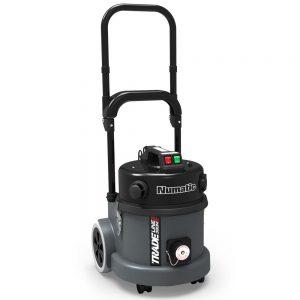
H-Class Rating (High Hazard):
The H-Class rating is assigned to vacuums designed for hazardous materials that pose a high risk to health, such as asbestos, lead, or carcinogenic dust.
H-Class vacuums offer the highest level of filtration and containment, ensuring that hazardous particles are safely captured and contained.
They are essential in industries like asbestos removal, lead paint abatement, and healthcare facilities where biological contaminants are present. ☢️🧼
In conclusion, industrial and hazardous vacuums are specialized tools tailored to the unique cleaning needs of industrial and hazardous environments. Their M-Class and H-Class ratings indicate their ability to safely manage hazardous materials, making them crucial for maintaining workplace safety and environmental compliance. 🌟🏭
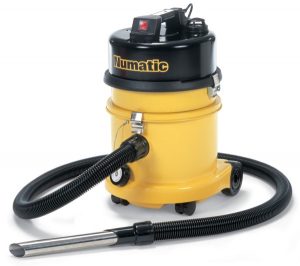
You can find our range of specialist & hazardous vacuum cleaners here.
You can find our range of industrial vacuum cleaners here.
It’s important to note that these vacuums are for specialist applications & are, therefore, not always in stock. We can order them in pretty quickly, though. Just contact one of our specialists!
For more information on Dust Explosions, check out this website.
====

Don’t forget to follow us on our socials for our latest updates:

